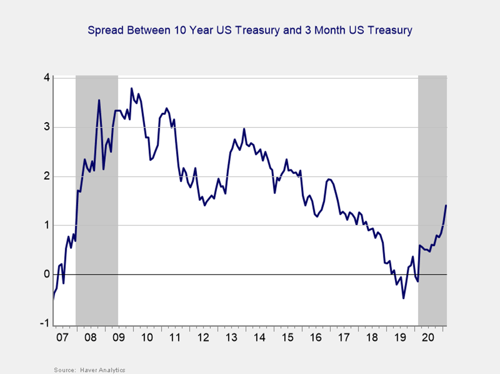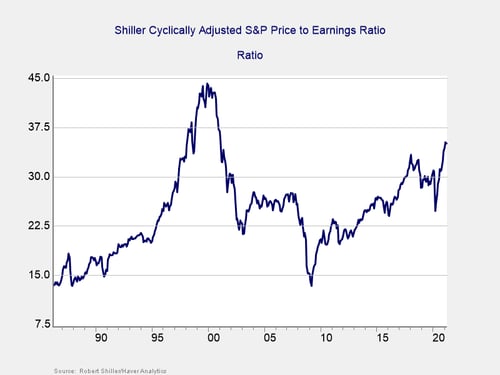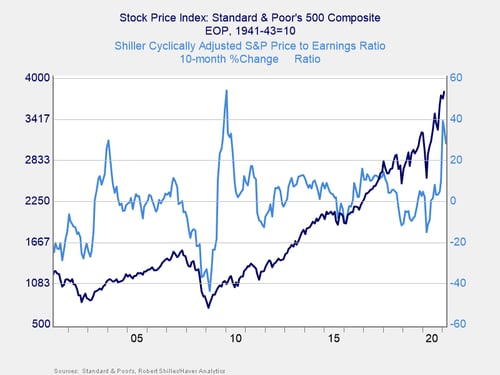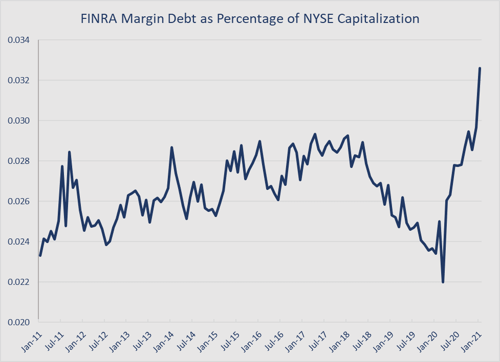 My colleague Sam Millette, senior investment research analyst on Commonwealth’s Investment Management and Research team, has helped me put together this month’s Market Risk Update. Thanks for the assist, Sam!!
My colleague Sam Millette, senior investment research analyst on Commonwealth’s Investment Management and Research team, has helped me put together this month’s Market Risk Update. Thanks for the assist, Sam!!
Equity markets rebounded in February despite some late-month volatility driven by a spike in U.S. interest rates. The S&P 500 gained 2.76 percent, while the Dow Jones Industrial Average rose by 3.43 percent. Riskier assets were hit hardest by the volatility at month-end, and the technology-weighted Nasdaq Composite gained 1.01 percent. Despite the overall positive results, the month-end volatility served as a reminder of the potential risks markets still face.
Recession Risk
Recessions are strongly associated with market drawdowns. Indeed, 8 of 10 bear markets have occurred during recessions. As we discussed in this month’s Economic Risk Factor Update, the National Bureau of Economic Research declared that a recession started last February. On top of that, two of the major economic indicators we cover monthly remain at concerning levels, despite the continued economic recovery during the month.
With that being said, February saw a noted increase in economic activity, which could signal a potential turning point toward faster growth looking forward. Given the improvements that we saw during the month, we have upgraded the economic risk level to a yellow light for now.
Economic Shock Risk
One major systemic factor is the price of money, otherwise known as interest rates. This drives the economy and financial markets and has historically had the ability to derail them. Rates have been causal factors in previous bear markets and deserve close attention.
Risk factor #1: The yield curve (10-year minus 3-month Treasury rates). We cover interest rates in the economic update, but they warrant a look here as well.

The yield curve started 2020 inverted, and it un-inverted last March, where it has remained throughout the pandemic. This un-inversion was initially driven by a sharp drop in short-term rates, caused by the Fed’s decision to cut the federal funds rate to effectively zero percent last March. The 3-month Treasury yield fell modestly in February, from 0.06 percent at the end of January to 0.04 percent at the end of February. The widening of the yield curve during the month was primarily caused by the 10-year yield rising due to increased inflation and economic growth expectations. The 10-year yield increased from 1.11 percent at the end of January to 1.44 percent at the end of February. This brought the 10-year yield close to the pre-pandemic high of 1.51 percent in January 2020. While short-term rates are expected to remain low until at least 2023, longer-term rates now sit near pre-pandemic levels, reflecting a normalization of growth expectations.
Although the spread between the 10-year yield and 3-month yield remains near the recession zone, it is approaching the level that historically has signaled a recovery. While this normalization process is a good sign for the ongoing economic recovery, rising rates can have a negative effect on stocks. In light of the headwinds that rising long-term rates can create for equity markets, we have left this indicator at a red light for now.
Signal: Red light
Market Risk
Beyond the economy, we can also learn quite a bit by examining the market itself. For our purposes, two things are important:
- To recognize what factors signal high risk
- To try to determine when those factors signal that risk has become an immediate, rather than theoretical, concern
Risk factor #1: Valuation levels. When it comes to assessing valuations, we find longer-term metrics—particularly the cyclically adjusted Shiller P/E ratio, which looks at average earnings over the past 10 years—to be the most useful in determining overall risk.

Valuations declined slightly in March, as the CAPE Shiller ratio fell from 35.2 in February to 35 in March. This broke a five-month streak with rising valuation levels; however, it still left the CAPE Shiller ratio at its second-highest level since the dot-com bubble.
Even as the Shiller P/E ratio is a good risk indicator, it is a terrible timing indicator. To get a better sense of immediate risk, we can turn to the 10-month change in valuations. Looking at changes, rather than absolute levels, gives a sense of the immediate risk level, as turning points often coincide with changes in market trends.

Here, you can see that when valuations roll over, with the change dropping below zero over a 10-month or 200-day period, the market itself typically drops shortly thereafter. This relationship held last March, as valuations and the index both rolled over before rebounding. On a 10-month basis, valuations rose by 28.1 percent in March, down from a 35.8 percent increase in February. Given the historically high valuation levels, we have kept this indicator as a yellow light for now despite the fact that valuation changes have remained outside of the danger zone since last May.
Signal: Yellow light
Risk factor #2: Margin debt. Another indicator of potential trouble is margin debt.

Debt levels as a percentage of market capitalization had dropped substantially throughout much of 2018 and 2019. Since then, we have seen margin debt increase, setting a new record as a percentage of market capitalization in January. The high level of debt associated with the market is a risk factor on its own but not necessarily an immediate one.
For immediate risk, changes in margin debt over a longer period are a better indicator than the level of that debt. Consistent with this, if we look at the change over time, spikes in debt levels typically precede a drawdown.

As you can see in the chart above, January’s debt level increased by 39.3 percent on a year-over-year basis, up from an already high 25.4 percent increase in December, which indicates that risks are rising. This marks the largest increase in margin debt since June 2000, when year-over-year debt levels increased by 52.1 percent. Given the increase in debt on both a monthly and yearly basis, and the fact that the overall debt level remains historically high, this risk is rising, and we have kept this indicator at a red light.
Signal: Red light
Risk factor #3: Technical factors. A good way to track overall market trends is to review the current level versus recent performance. Two metrics we follow are the 200-day and 400-day moving averages. We start to pay attention when a market breaks through its 200-day average, and a break through the 400-day often signals further trouble ahead.

Technical factors remained supportive for equity markets in February. The S&P 500, which managed to break above its 200-day moving average at the end of May, finished above trend for the 10th month in a row. This also marks eight straight months with all three major indices finishing above trend.
The 200-day trend line is an important technical signal that is widely followed by market participants, as prolonged breaks above or below this trend line could indicate a longer-term shift in investor sentiment for an index. The 400-day trend line is also a reliable indicator of a change in trend. The continued technical support for markets in February was encouraging, so we have left this signal at a green light for the month.
Signal: Green light
Risk factor #4: Market complacency. This is a recently added risk factor that aims to capture a standardized measure of market complacency across time. Complacency can be an uncertain term, so this chart aims to identify and combine two of the common ways to measure complacency: valuations and volatility.
For the valuation component of the index, we are using the forward-looking price-to-earnings ratio for the S&P 500 over the next 12 months. This gives an idea of how much investors are willing to pay for companies based on their anticipated earnings. Typically, when valuations are high, it signals that investors are confident and potentially complacent. For volatility, we have used the monthly average level for the VIX, a stock market volatility index. When volatility for the S&P 500 is high, the VIX rises, which would signal less complacency.
By combining the two metrics in the chart below, we see periods where high valuations and low volatility have caused peaks, such as 2000, 2006 to 2007, and 2017. We saw market drawdowns roughly within a year following each of these peaks.

Looking at the current market, market complacency does not appear to be approaching dangerous levels. While valuations have increased along with the market this year, there has been enough volatility to cause the VIX to remain elevated compared to pre-pandemic levels. The market complacency index increased modestly during the month, rising from 0.86 in January to 0.92 in February. This leaves the index below the 1.0 level we saw last December.
We are keeping this indicator at a green light due to the fact that the index still sits below the historical trouble level of around 1.2.
Signal: Green light
Conclusion: Market Risks Remain Despite Economic Improvement
Economic fundamentals showed faster growth in February, largely driven by improvements on the public health front and the stimulus checks that hit bank accounts during the month. We saw encouraging results for consumer confidence and spending reports, as well as much better-than-expected earnings results for the past quarter. Given the improving economic fundamentals, we are approaching a potential upgrade for the overall market risk indicator, but there are still risks that should be monitored.
One of the primary risks for markets is economic success and the potential effects rising long-term rates may have on equity valuations. We saw this at the end of February and into March as rising rates caused market turbulence, especially for riskier asset classes. The pandemic still represents a risk for markets, although given the declining case counts and rising vaccinations, this risk appears to have subsided recently.
Ultimately, the road back to normal is likely going to be long with the potential for setbacks to cause further market pullbacks in the months ahead. Given the possibility for further volatility, investors should remain cautious on equity markets for the time being, and we have left the overall market risk indicator at a red light for now.



 Print
Print

